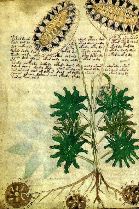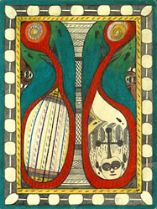We subscribe to Scientific American and while I can’t say I read the mag, I’m a big fan of browsing the images — always visually rich.

July’s issue, which has some wonderful Hubble photographs of nebulae (dying stars), also had a back of the mag story about a mysterious medieval tome, the Voynich Manuscript.
The 200 page book of bound vellum is written in undecipherable code and illustrated with all manner of charts and diagrams, strange flora and fauna, and bevies of nude women bathing. (top image is page from the Voynich manuscript)
Now it may be that the Voynich, dating from 1470-1500 and lost and found over time surfacing in 1912 when Wilfrid Voynich, a rare book dealer, found it in Rome and brought it to the world’s attention, is a book of mysticism. That’s one theory.

There’s another theory that the book is a 15th century hoax perpetrated by someone wanting to make a fast buck off of Emperor Rudolph II, who bought the manuscript for 600 ducats.
I wonder if it isn’t rather a piece of medieval outsider art, made by the 15th century equivalent of Adolf Wolfli, someone possessed by a need to transcribe inner-fueled, incomprehensible stories who also is a whiz at drawing. (image left is a Wolfli drawing)
Here’s a good website for more on Voynich. And here’s more on Wolfli.
And check out Scientific American next time you’re at the library. I swear the pictures are life imitating art.









